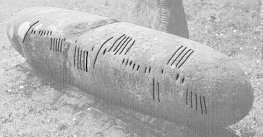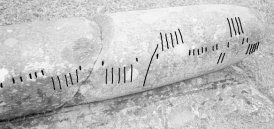According to H. Pelham (Vallancey, Coll. 6, ch. 4, 185), this stone was seen by him in 1790 "standing whole in the midst of the village" called "Ballysteeny, or, as some old papers in my possession spell it, Ballyna-stenigh, .. two miles east of Dingle" (the name of the village is misspelt "Ballyfeeny" in Brash, OIM 176 and Macalister, CIIC, obviously because of the st-ligature used in Vallancey's article). - Brash states (OIM, 178) that there is "no church or Christian burial-ground" near the site; there is, however, "a Keel on the next townland of Lisdorgan; to the north of which, Mr. Hitchcock states, is a holy well, at which stations are performed."
Before 1804, the stone broke into two parts. According to Pelham (l.c.), this was due to "fire made against it"; by 1804, "the bottom still (stood) in its original situation" while "the top (had) been removed, and sunk into the ground at the corner of a cabin. (According to Macalister, it was the back part which was "flaked away"). Brash states that the stone was visited in 1838 by Windele who found it broken in "two pieces, the larger one sunk in the earth against the quoin of the Widow McDonnell's house, on the townland of Ballysteenig; he had to break away a portion of the masonry to copy some of the characters." Brash himself visited the stone in July, 1868, lying "in the farmyard of John Griffin, a few yards from the mail-coach road between Dingle and Aunascal, and about two miles from the former." At that time both parts were kept separately: "the upper portion was performing the ignoble duty of propping up a turf rick; the lower was built into an external angle of the fence of a small field, to the rear of his cottage".
Between the publishing years of Ferguson, OI (1887) and Macalister, Epig. 1 (1897) the stone was brought to Burnham into the lands of Lord Ventry where it is still today (together with four stones from Ballinrannig, {148, 149, 150, 151} and one more stone {175} of unknown provenance).
According to Brash, OIM 178, the stone "appears artificially formed", different from the Ballintaggart monuments {155-163} which "have been rolled into (their) present shape by the action of the waves on the sea-shore".
In his description of the stone, Pelham made no attempt of reading it. He dealt a lot, however, on the name of the town which he derived from a word meaning the membrum virile, the stone being taken as a Phallic symbol.
Estimated original size according to H. Pelham (in Vallancey, Collectanea 6, ch. 4, 185): "about eight feet".
Original size according to Brash, OIM 177: 7'5" x 1'3"
Size according to Macalister, CIIC: 6'4" x 1'1" x 1'2";
size according to DPAS, no. 791, p. 250: 1.98m x 1m (circumference).
Published illustrations:
- Pelham in Vallancey, Collectanea 6, pl. III (woodcut of the stone standing in upright position, showing the inscription ending with MAQI);
- Graves apud Ferguson, PRIA 15, 1871, 56 (
 woodcut).
woodcut).
- Brash, OIM pl. XVII (
 draft)
draft)
- Macalister, CIIC I, 143 (frontal and back side);
- DPAS, 250, fig. 138 (draft, after Ó Tuama).
MOINUNA MACUI OLACON
[The reading was noted by Graves in half uncial script, which obviously means a transposition into normal ms. form; instead of CU the accompanying  woodcut shows Q.]
woodcut shows Q.]
"We seem to find a footing in an early part of the field of Ecclesiastical history. OLCHU was grandfather of St. Brendan; and MAOINEANN was the Bishop attached to St. Brendan's Monastery at Clonfert. He died in the year 571 (Tigh.). OLACON is plainly the genitive of Olchu." - The stone had been referred to before by Graves in PRIA 4, 1850, 177, as bearing the name "of Moinuna, a distinguished disciple of St. Brendan".
ᚋᚑᚔᚅᚓᚅᚐᚋᚐᚊᚔᚑᚂᚐᚉᚑᚅ
MOINENAMAQIOLACON
"MOINENA, THE SON OF OLACON"
The E is not certain because it is damaged by the fracture. - It is not sure whether this means Moinuna, disciple of St. Brendan's, because "the name was a usual one. We have Monenna, a sister of St. Patrick's, and a Moenan, son of Cormac, A.D. 774. In the Mart.Don. p. 147, we have Moninne, a virgin .., and at p. 186, Moninne, a virgin .. The name here is masculine", however. "Gaulish forms, Menimana.. Stein, 544; Monimianus (Manius?).. Gruter.. 694,14. Moenius, Grut. 918, 19 Patav. - Again, it is unlikely that `a distinguished disciple of St. Brendan's' would have been interred in unconsecrated ground, as in this locality there is no Christian Church or burial-place; and no reverence whatsoever is attached to the stone. Again, it is unsanctified by the symbol of redemption, or the usual formula of Oroit, or Bendacht .. here we have nothing beyond the simple pagan form of inscription." - Olacon is not a genitive of Olchu as proposed by Graves but nominative as in the Book of Lecan, fol. 281 where we have Allican "in a poem by Flann-Mainistreach, who died A.D. 1056, in which he gives an account of the deaths of several of the Tuatha-de-Danann chiefs". Similarly we have Ollchan in the Book of Ballymote, fol. 21, in a "curious and ancient poem ascribed to Fintan, a poet and historian, who appears to have communicated to St. Patrick much information on the early history of Ireland. .. In later ages the name appears" as Allacan A.D. 912, Ullachan 932, O'Leochain 992" etc., "and as O'Lachan 1050". - "The finding of Olchu in the genealogy of Brendan was no doubt a great temptation to identify him with a monument found in the district of his grandson's labours. The tendency to identify local historic or traditionary names with those found on Ogam monuments has been a serious impediment to their study, and has led to a large amount of elaborate and useless philological criticism. Oreli's collection, No. 288, gives us the Gaulish form, Olkano."
MOINENAMAQIOLACON
"Moinena maqi olacon".
Considering Graves's suggestions, it "seems not improbable" that the Bishop named Moinena "should have been interred in Brendan's ancestral district .., and certainly no one can reasonably .. question the appropriateness of the cross which accompanies the inscription."
ᚋᚑᚔᚅᚓᚅᚐᚋᚐᚊᚔᚑᚂᚐᚉᚑᚅ
MOINENAMAQIOLACON
"Olacon is, of course, genitive of Olchu, but the Olchu here mentioned cannot be St. Brendan's grandfather", because we would have to expect *Olacona or even *Olaconas on a monument of his time. Instead the present inscription has to be dated into the 9th cent. "at earliest". - Moinena has to be taken as a genitive, not as a nominative as in Brash's treatise; "it is, as Professor Rhŷs has shown, a Pictic genitive taken as base of a Goedelic genitive - Moin-en-a+lt;s+gt;. The name Moin-, Mon- is not unknown"; cp. Moan, son of Muircertach mac Erca in the Book of Fenagh.
MOINENA MAQI OLACON
There is a fracture crossing the E letter so that this was readable as a U. Pelham's drawing shows the "fifth letter correctly as E, with a crack running through it; but he breaks off the top of the stone after the I of MAQI"; was OLACON "buried and inaccessible" at that time?
MOINENA MAQI OLACON
This could have to be read *OLACONA, expecting both names to have the same ending. - The inscription dates from the 5th or 6th cent.
Reading DPAS, no. 791, p. 250 (quoted in OSDP??)
MOINENA MAQI OLACON
"The fracture across the middle of the stone removed two of the E scores but otherwise the inscription is clearly legible".
MOINENA MAQI OLACON
Reading Gippert (1978/1998):
 "Surface angle - left to right":
"Surface angle - left to right":
MOIN[E]NA MAQI OLACON[A]
ᚋᚑᚔᚅ[ᚓ]ᚅᚐᚋᚐᚊᚔᚑᚂᚐᚉᚑᚅ[ᚐ]
ᚋᚐᚐᚐᚐᚐᚐᚐᚁᚁᚁᚁᚁᚐ[ ]ᚐᚁᚁᚁᚁᚁᚐᚋᚐᚆᚆᚆᚆᚆᚐᚐᚐᚐᚐᚐᚐᚁᚁᚐᚆᚆᚆᚆᚐᚐᚁᚁᚁᚁᚁ[ᚐ]
The last name might possibly be read as OLACONA, but it can hardly be decided upon whether the notch that can be recognized after the final N was intended as an Ogham vowel at all. - Of the supposed E in the first name, only the first and the last notch is preserved, the other two scores having got lost because of the  fracture of the stone. Pelham's woodcut (Vallancey, Collectanea 6, Pl. III) shows a clearly readable E in MOINENA MAQI.
fracture of the stone. Pelham's woodcut (Vallancey, Collectanea 6, Pl. III) shows a clearly readable E in MOINENA MAQI.
 woodcut).
woodcut). draft)
draft) woodcut shows Q.]
woodcut shows Q.] "Surface angle - left to right":
"Surface angle - left to right": fracture of the stone. Pelham's woodcut (Vallancey, Collectanea 6, Pl. III) shows a clearly readable E in MOINENA MAQI.
fracture of the stone. Pelham's woodcut (Vallancey, Collectanea 6, Pl. III) shows a clearly readable E in MOINENA MAQI.